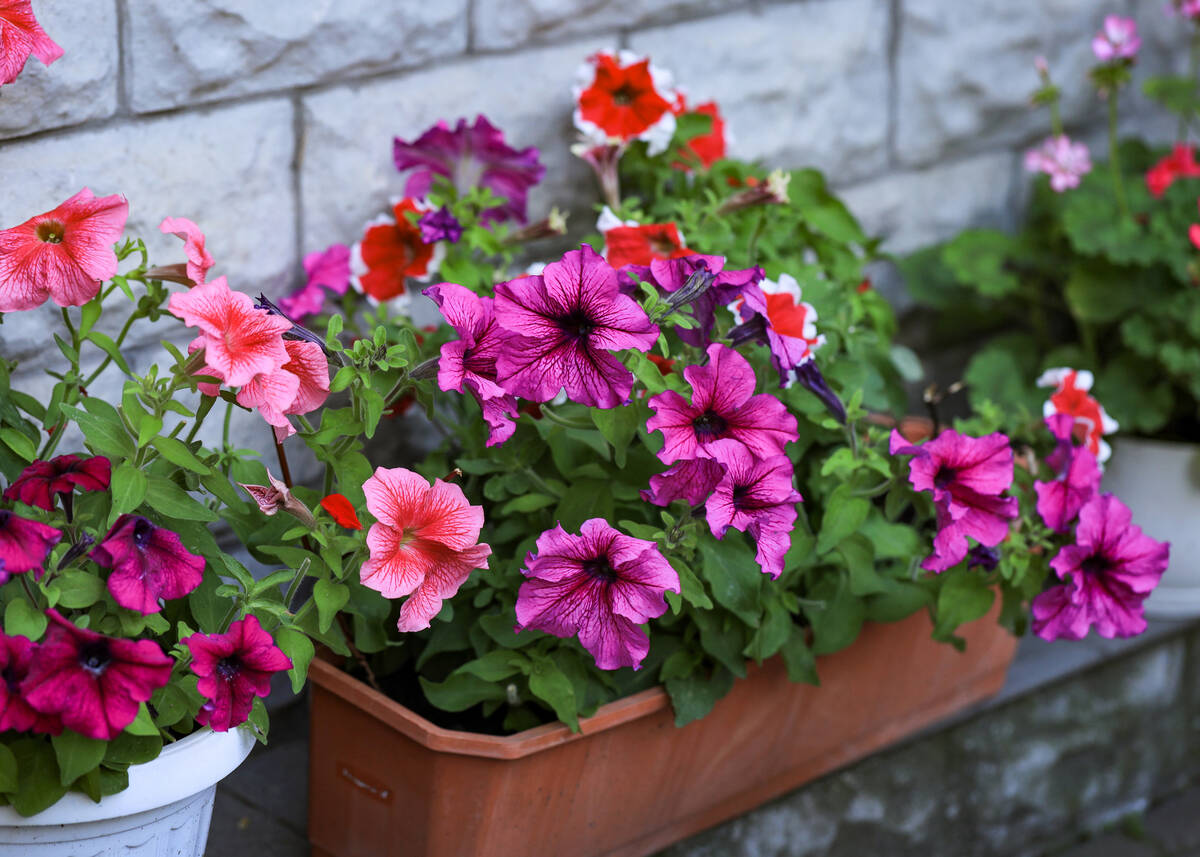Some petunia varieties can stand up to our summer heat
Q: Recently, I was given a tray of petunias. My yard is a half-acre of desert landscaping and many large pine trees. The house faces north. The yard itself is not conducive to planting delicate flowers. I have raised planter areas against the east wall of the back yard that receive limited sun. While I would like to use large containers on my front porch, it receives no direct sun. I would appreciate any advice on planting these very nice flowers.
A: Remember, annual flowers like petunias and snaps need to be watered daily during the hot months, must have lots of light (indirect light is OK if there is enough), and require organics in the soil. Trees prefer not to be watered daily. Avoid planting annuals at the base of trees.
There are lots of different kinds of petunias — I’m talking about varieties. For instance, the Madness Summer Series of petunias can take the heat, but petunias are not known for that (or for withstanding long periods in direct sun). Petunias usually like cooler weather and should be removed before it gets too hot or too cold. Make sure the soil has been amended with about 25 percent compost before planting petunias of any kind.
Check with your local nursery and get their recommendations for hot-weather petunias. If the Madness Summer Series still exists, then I would stay with them. They are reliable and I have had a lot of luck with those. At least these petunias will handle the heat of summer, while other hybrids may not.
Pests to watch out for include the tobacco bud worm, which is controlled with Bt (Bacillus thuringiensis, a naturally occurring bacterium that is toxic to the caterpillars of young moths, butterflies and some beetles. Chemical control includes pesticides that contain imidacloprid as the active ingredient.
Q: Can we grow soursop for its fruit in Las Vegas Valley?
A: Soursop (Annona muricata) is a tropical fruit with a creamy texture and a strong flavor that grows in the tropical parts of Africa, South America, and Southeast Asia. It’s also known as graviola, guanabana and guyabano there. The flavor is hard to describe, but when fresh the fruit’s taste is close to a cross between citrus and pineapple.
It is like I would tell my students: “You can grow anything in Las Vegas … if you are willing to put the time, effort and money into it. First you need a greenhouse …”
I have about 15 soursop (guyabano) on our farm in Batangas, Philippines. With this particular tree fruit, it may only grow in the tropics.
Soursop trees are reported to get chilling injury at temperatures below 45 degrees. Temperatures below 40 can damage leaves and small branches, and temperatures below 37 can be fatal to the tree. Our temperatures regularly get below 37 degrees in wintertime.
You are better off trying to grow the subtropical to tropical cherimoya (another Annona species). I think the chilling injury is not as pronounced, and they can handle our winter temperatures better than soursop.
Q: I have a Joshua tree that was planted near the swimming pool some 35 years ago. One of the stems has died off. Is this something that should be removed or left alone?
A: Check for borers in the roots if you are happy with your watering regimen. The yucca weevil can damage Joshua tree. It is more common to find them in American agave. The standard treatment for borers in Joshua tree is the same as for fruit trees (minus not eating the fruit for 12 months).
Use imidacloprid (look for it in the list of active ingredients) as a soil drench. Apply this chemical mixture immediately after the flowers have dropped (to protect pollinators). Follow the label directions. The roots will be close to where water is applied. It’s not needed more than once each year.
Otherwise, check how often you are watering. Watering too often is more detrimental to native plants than watering with more water all at once. Once they are established, Joshua trees should be watered, deeply and widely, not more often than once a month to every other month.
Q: I saw sticky residue on my roses and white spots. When I enlarged a photo, it was clearly some type of bug. What is the best method/product to use to control these bugs?
A: You will buy two insecticides: one to kill the aphids on roses and one as bait to kill the ants. The bait is applied close to the ant nest and kept dry for at least 24 hours.
Those insects in your picture are aphids, sometimes called plant lice. The insects in your picture drop sticky exudate as they suck plant juices. Ants like to give this exudate to their young because it contains a lot of sugar and plant nutrients.
Ants transport aphids from leaf to leaf and farm them like cattle. Any rose insecticide will control aphids. The aphids will come back faster if the ants aren’t controlled. Use a bait for controlling the ants.
Bob Morris is a horticulture expert and professor emeritus of UNLV. Visit his blog at xtremehorticulture.blogspot.com. Send questions to Extremehort@aol.com.

















